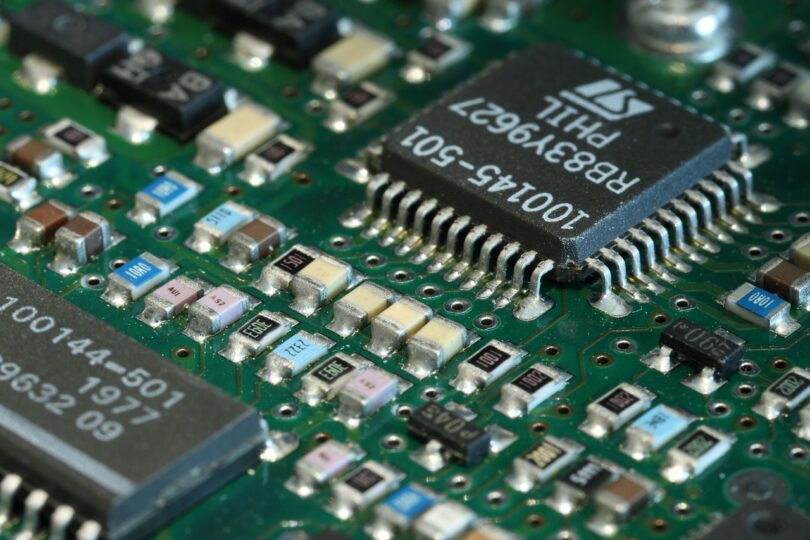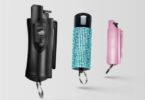Flexible PCB are primarily used in modern compact electronic devices due to their flexibility and nature to fit in compact spaces without losing circuit size. Flex PCB circuits are expensive to manufacture compared to other PCB circuits due to their unique construction material.
Flex PCB thin flex substrates and other materials allow them to take any shape and resist breaking during flexing. Flex PCB circuits are mostly made up of flexible base material, copper metal conductor layers, various types of overlays, adhesives, and stiffeners.
Flex PCB circuits can be utilized separately or in conjunction with other PCB materials, such as FR4 PCB substrates. In this instance, they are known as rigid-flex PCBs. There are other flexible PCB boards, such as single-layer Flex PCB, double-layer Flex PCB, HDI Flex PCB, and multilayer Flex PCB circuits.
Flexible PCBs provide unlimited design flexibility since they may be bent, twisted, or shaped to reduce size and space. Because of thinner PCB materials and lower PCB volume, its weight is less than other PCBs, which is why these PCB circuits are commonly utilized in military, aerospace, and space-driven electronic devices.
1. Substrate and Coverlay Films
The substrate is the flex base of the Flex PCB circuit. The dielectric or flex substrate used in flexible PCB are mostly PI films. Polyester film PET, aromatic polyamide paper, liquid crystal polymer, and fluorocarbon film are other specialized materials used as the substrate for Flex PCB circuits.
Coverlay is a layering material used in Flex and types of Flex PCB circuits and is composed of PI layers and epoxy or an acrylic-based elastic adhesive. It acts as a protective finish in Flex PCB circuits and protects them against environmental degradation. They also enhance the look and functionality of Flex PCB circuits.
2. Conductors
Copper metal foil is mainly used as the conductive layer in Flex PCB circuits. Instead of employing typical electroplated copper metal foils, PCB manufacturers utilize high-quality rolled-annealed copper metal foils as conductive layer foils in flex PCB construction.
In single-layer copper metal, foil is single-sided; other than that, they are used in various layers of flexible PCBs. Flex PCB majorly uses FR4 or PI, or Al stiffeners to provide stiffness to the selected non-flexing areas on flex PCB circuits.
3. Adhesives
PI-based Resin, modified epoxy-based Resin, acrylic-based Resin, and PET-based Resin are used as adhesive materials in flexible PCB material. These materials help in bonding layers. All layers are heated and pressed to form layers of flexible PCBs.
Single Layer Flex PCB:
The most fundamental type of flexible PCB circuit is the single-layer flex circuit, which is made of a flexible PI film base and bonded to a thin layer of copper foil on one side. This copper foil layer is chemically etched over a flexible base to create a circuit layout customized for specific electronic device design specifications. A PI coverlay is lastly applied to the flex circuit for environmental protection and insulation.
Uses of Single layer Flex PCB
Single-layer Flex PCB is used in simple to complex modern electronic devices requiring a high volume of flexing and compression. They can be used in both dynamic and flexible applications. It is used in devices such as Hearing aids, cameras, calculators, printers, GPS systems, automotive engine controls, satellites, and avionics.
Construction of Single layer Flex PCB
These Flexible PCB circuits are constructed by etching copper metal foil layers over PI base or other flex PCB substrates on a single side. Cover lay is also used in this construction. It protects this single-layer Flex PCB from environmental degradation and enhances its structure.
Flex PCB: Getting Started with a Flex PCB Design Guide
Flex PCB Designing is different as compared to rigid PCB boards. There are several elements to consider while constructing a Flex PCB circuit, ranging from construction materials to the vias used. Below are a few guidelines for designing a flex PCB design:
Type of Bending required in the circuit
Flexible PCBs can be static or dynamic depending on the nature of their flexing in the application. We also have to design our flex circuit in this category that our Flex PCB circuits will use in electronic devices.
Dynamic
This type of flexible circuit flexes several times during an electronic device’s functioning. They can resolve several connections and packaging issues in designs requiring repetitive motion.
Static
This type of flex circuit is rarely flexed in their devices, which is why they are also known as bend-to-install flex circuits.
Bending Radius
During mechanical testing, the best part of the Flex PCB must be viewed as a bent rectangular section while designing a Flex PCB stackup and inserting traces on flexible PCBs. This is critical for calculating the proper trace thickness to avoid breaking and failures.
A larger bending radius is used; otherwise, there are chances of breakage during operation. Dynamic, flexible PCB must not surpass a 90-degree bending angle. While in static, it will bend over the yield point to strengthen it against breakage.
Routing and Conductors
Routing represents the path electric charge takes from one location to another in a flex PCB circuit. This factor needs to be considered as well while designing. We must examine the conductor metal patterns to see whether the bending will alter it. Copper conductors have to be routed as perpendicularly as practicable across curve locations.
Use of Vias
Buried and blind vias must be used in multilayer flex PCB circuits during the designing process to connect Flexible PCB layers. The use of vias always depends on the final design of the required Flex PCB circuit.
Use of Pad fillets
Pad fillets are used to design features of Flexible PCBs. Whenever this pad fillet diameter is more significant than the joining strand width, it will enhance etched output and material properties.
Use of Tear relief and Stiffeners
A rescue gap and high corner radii are two popular methods for eliminating splits in a Flex PCB circuit. Similarly, mechanical stiffeners are used to stiffen your flexible PCB’s SMT, connection, and other locations.
Operating Environment
The environment in which your Flex PCB will operate also plays a critical role in its design. Thus, ensure the application these flex circuits will use to design it perfectly.
The Flex PCB Design Process
The flex PCB designing process begins with creating a stackup, followed by the placement of components, structuring and routing of copper traces, and tidying up the Flex PCB layout in preparation for manufacture. The distinction between flexible and rigid-flexible PCB is the addition of a connection that extends flex portions into the flex-rigid PCB board’s rigid edges.
Additional procedures, such as applying stiffener, choosing a coverlay or soldering mask material, or specifying a static or dynamic bending in the Flex PCB design, are necessary to guarantee that the flexible section has the necessary mechanical characteristics.
Stackup layout is an essential aspect of the flex-rigid PCB designing phase because it integrates stiff portions in flex-rigid PCB. Furthermore, factors such as copper metal foil weight, component placement, and routing density in specific board areas might limit flexibility, giving a rigid-flex PCB board edge over a Flex PCB board.
To begin with, a flexible or rigid-flexible PCB design considers the assembly operations and how the layout will be incorporated into its device and then starts designing.
Floor planning
While floor planning, the design considers where the Flex PCB board would flex and how its layout will fit inside its device. Components must be kept out of the folding and installation regions, and you may wish to employ a rigid portion for particular high pin-count Integrated circuits or HDI circuits.
Layer count:
Decide the layers of flexible and rigid material required for Flex PCB and Rigid-flex PCB design during design and them in design guidelines to avoid issues in the final layout of the circuit. For the rigid portion, layers will be placed in the center of the stackup.
Stiffness
Add stiffeners in the Flex PCB design where stiffness is needed in the design.
High-pin density components
SMT components are placed over the Flex portions of the circuit during the designing phase. For RF or HF PCB designs, plane layers are added to improve impedance in design.
Materials for Flex/Rigid-Flex PCBs
Flexible and rigid-flexible PCB circuits are made from various PCB materials to fulfill various cost objectives and electrical and physical success criteria. Due to this variation and the potential risks associated with each option, the PCB designer must offer specific information about the flexible dielectric materials and rigid substrates used in Flex and rigid-flex PCB.
To simplify its manufacturing process, PCB designers must familiarize themselves with the price and performance options available in rigid-flex and Flex PCB material. Mostly annealed and rolled copper metal is used as conducting layer in rigid-flexible and flex PCB circuits.
While FR4, PI, and PET are used as substrates. PI resin-based adhesives join the layers of rigid-flexible and flexible PCB circuits. One mil polyimide is used as coverlay. Some designs even replace the coverlay with a thicker soldering mask for better design. A laminated flexible cover layer is also used in some designs.
Flexible Base and Coverlay Materials
PI, PET, aromatic polyamide paper, liquid crystal polymer, and fluorocarbon film are other specialized materials used as the Flexible Base for Flex PCB ad rigid-flex PCB circuits. Due to their thickness, complexities, and different component requirements, specific rigid-flex PCBs use coverlay and LPI soldering masks.
Each is applied precisely to specific sections of the component and benefits several substances within a single design. The Printed circuit fabrication files are designed such that the two substances do not overlap inside the rigidized regions of the design.
As a result, the circuit is completely encapsulated even without the formation of mechanical bending stress extractors in the flexible portions. If this is permitted, the part’s dependability may be jeopardized. While this technology incurs some more costs, the rigid-flex PCB structure may require it, and the component’s advantages exceed the additional costs.
There are two popular coverlay and LPI soldering mask setups used:
- Apply LPI soldering mask to rigidized component locations and coverlay to flexible portions.
- Alternatively, in teamed coverlay apertures, apply selected connections of the soldering mask.
1. Stiffeners:
Stiffeners are added to Flex PCB ad rigid-flex PCB circuits to support heavy components. It even provides strength to the designs. Different stiffeners are required for different applications and components to enable mechanical characteristics in the flex ribbons or PCBA of Flex and rigid-flex PCB circuits.
2. FR4 stiffener:
The most basic stiffener is the rigid flame retardant four epoxy-filled fiberglasses, which is basically placed as a laminate across the flexible region.
3. Rigid polyimide:
By layering additional PI sheets to achieve a localized thickness gain in Flex and rigid-flex circuit, a rigidized PI layer may be utilized to harden an area. When ending with a ZIF connection, a PI stiffener is typically utilized to construct to the necessary thickness.
4. Connector/component stiffeners:
For this purpose, FR4, or PI, metal can be thermally connected with a pressure-sensitive or flexible adhesive.
Flexible Circuit Designs with Large or Heavy Components
To design a flexible circuit design with large or heavy components, use a rigidized flex circuit which is different from a rigid-flex circuit and helps to add heavy components in a flex PCB circuit without affecting its performance.
A rigidized flex circuit is a flexible PCB with an Fr-4 substrate stiffener added for heavy component security. This stiffener serves just as a mechanical assistance. A rigid-flex PCB, in contrast, will generally feature circuit elements on the rigid PCB layers and attach the flexible and rigid layers through plated thru holes.
A flexible PCB design with an extra Fr-4 substrate stiffener is a reasonable and less expensive option than a rigid-flex PCB design. However, a rigid-flexible architecture needs to be used when there are several greater density component regions, particularly on the opposite sides of the PCB board.
Final words
Flex PCB material adds unique bending, toughness, and flexibility to the Flex PCB circuit, making them lightweight and reliable for various electronic devices. For the best quality flex PCBs and their material, contact Heimeixin PCB today!
To provide quality services and PCB manufacturing, we deal with the best PCB materials, such as Rogers, Panasonic, Isola, Taconic, and much more.








Leave a Comment
You must be logged in to post a comment.